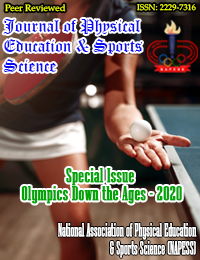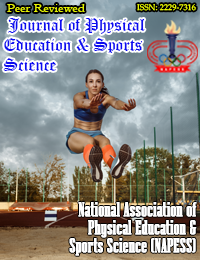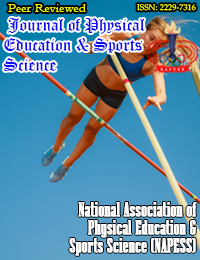Effects of a Ploymetric Training Programme on Selected Physiological Variables of Adolescent School Going Boys
Download PDF
Effects of 10 weeks participation in a Ploymetric Training programme on Selected Physiological Variables on 80 numbers of adolescent students were studied. Result of the study indicated that the Ploymetric training programme have yielded positive changes by the subjects. The pre-test and post-test comparisons in respect of all the selected Physiological variables were positive and significant at 0.05 level of significance.
ABSTRACT:
Effects of 10 weeks participation in a Ploymetric Training programme on Selected Physiological Variables on 80 numbers of adolescent students were studied. Result of the study indicated that the Ploymetric training programme have yielded positive changes by the subjects. The pre-test and post-test comparisons in respect of all the selected Physiological variables were positive and significant at 0.05 level of significance.
Key Words: Ploymetric Training, Physiological Variables: Resting Heart Rate, Resting Systolic Blood Pressure, Resting Diastolic Blood Pressure.
Introduction:
Plyometric training is now a common element of elite sports training programmes, and is increasingly used by other athletes and their coaches. But while its beneficial effects on the lower body are well documented, there are some lingering doubts over how useful it is for upper body force development.
First documented as an effective training method by Soviet coaches in the middle of the last century, the main purpose of ‘plyometrics’ is to increase the rate of force development, the key ingredient of power. By contrast, the main purpose of heavy weight training is to increase total force production – i.e. maximum strength.
It is logical for athletes to seek to increase the rate of force development, because most sporting movements involve fast movements for which forces must be generated quickly. The foot-to-ground contact time in the high jump, for example, is less than 100 milliseconds, yet it will take around 500 milliseconds to generate maximum force. For elite performance, an athlete’s rate of force development is often more important than the maximum force he or she is able to generate.
The other advantage of plyometric training is that it comprises jumping and throwing movement patterns that involve a stretch-shortening-cycle (SSC). The muscle and tendons are first lengthened with an eccentric load – e.g. pulling back your arm to throw a ball – which may increase the subsequent concentric force production and/or allow release of elastic energy – e.g. as the arm accelerates forwards to release the ball. Since most sporting movements involve sprinting, jumping and throwing SSC movements, plyometric training can be viewed as highly sport specific.
Power (P) can be developed by improving strength and speed of the muscle contraction or both (P= force x velocity). In competitive sports the athletes and players are unable to place their strength or speed to work in a power movement. New methods and improved techniques have been introduced and developed to bridge the gap between strength and speed of numerous sports. Exercise physiologists, sports scientists, coaches and athletes have searched for an effective method to combine strength and speed using one training technique. Plyometrics has been developed as such a technique to meet an end to the searches. Plyometrics has been defined as drills or exercises whose purpose is “linking sheer strength and speed of movement to produce an explosive-reactive type of movement” (Chu & Plummer, 1984, p.30).
Few studies have investigated the effects of ploymetric training. The storage of elastic energy and the stretch reflex mechanisms within the muscles are two major physiological effects of ploymetric training (Thomas, 1988; & Mann, 1981). Thomas (1988) stated that improvement in muscular force and jumping ability during Plyometrics are related to such concept of stretch reflex and elastic recoil respectively.
The purpose of the study was to find out the effect of a ploymetric training programme on selected physiological parameters of adolescent school going boys.
Materials and Methods:
The study was conducted on 40 numbers boys belonging to class IX and X. All subjects were fully informed of the risks and discomfort associated with the investigation before accepting their willingness to act as subjects. Subjects were randomly selected into two groups of 20 subjects each. Group A, the experimental group participated in ploymetric training. Group B, the control group were allowed to perform their regular physical activities but denied for participation in ploymetric training. The training stimuli adopted for a six week long included ploymetric training exercises as listed below.
Ploymetric Training Exercises:
1. Exercises for Lower Extremities:
- Spot Jump
- Standing Jumps
- Multiple Hop Jumps
- Box Drill
- Depth Jump
2. Exercises for Upper Extremities:
- Front toss
- Over-under pass
- Trunk rotation
- Over head throw
- Rotation in eight figure.
The above stated Ploymetric exercises were performed thrice in a week for one hour in the afternoon under the direct supervision of the investigator. Prior to practicing the exercises the subjects were being asked for getting warmed-up for 10 minutes and to follow the demonstration of each exercise.
Data Analysis:
Test scores were subjected to statistical analysis. Indices like means and standard deviations were computed for comparison. The mean and standard deviation values were calculated for the three physiological variables: (a) Resting Heart Rate, (b) Resting Systolic Blood Pressure, and (c) Resting Diastolic Blood Pressure. To find out significance of the difference or the change that occurred between pre-and-post tests, ‘t’ test was applied.
Table 1
Mean, SD Scores and Result of the Test of Significance (‘t’) in respect of Physiological Variables of Experimental and Control Groups.
Physiological Variables |
Groups |
Pre-test |
Pos-test |
‘t’ |
||
Mean |
SD |
Mean |
SD |
|||
Resting Heart Rate |
Group B |
74.5 |
3.73 |
74.6 |
2.61 |
0.326 |
Group A |
78.6 |
6.45 |
75.6 |
4.36 |
4.68* |
|
Resting Systolic B.P. |
Group B |
117.7 |
8.92 |
117.8 |
8.36 |
0.37 |
Group A |
114.5 |
6.35 |
117.5 |
8.48 |
3.94* |
|
Resting Diastolic B.P. |
Group B |
75.7 |
6.07 |
75.8 |
5.79 |
0.32 |
Group A |
75.1 |
5.27 |
78.3 |
6.9 |
3.7* |
|
Table 1 indicates significant differences between pretest and posttest of the Experimental Group (Group A) on all the physiological variables namely Resting Heart Rate, Resting Systolic Blood Pressure, and Resting Diastolic Blood Pressure. Whereas no significant difference are observed between pretest and posttest of the Control Group (Group B) on all stated physiological variables. In case of Resting Heart Rate of Experimental Group (G-A) the obtained‘t’ value was 4.68 and found to be greater than the required ‘t’ value (2.09) and significant at 0.05 level of significance with 19 degrees of freedom. The Resting Systolic Blood Pressure of Experimental Group (G-A) the obtained‘t’ value was 3.94 and found to be greater than the required ‘t’ value (2.09) and significant at 0.05 level of significance with 19 degrees of freedom and the Resting Diastolic Blood Pressure of Experimental Group (G-A) the obtained‘t’ value was 3.7 and found to be greater than the required ‘t’ value (2.09) and significant at 0.05 level of significance with 19 degrees of freedom.
Conclusion:
The six week long ploymetric training programme on the adolescent students have proved to be effective on selected physiological variables and significant at 0.05 level of significance.

















